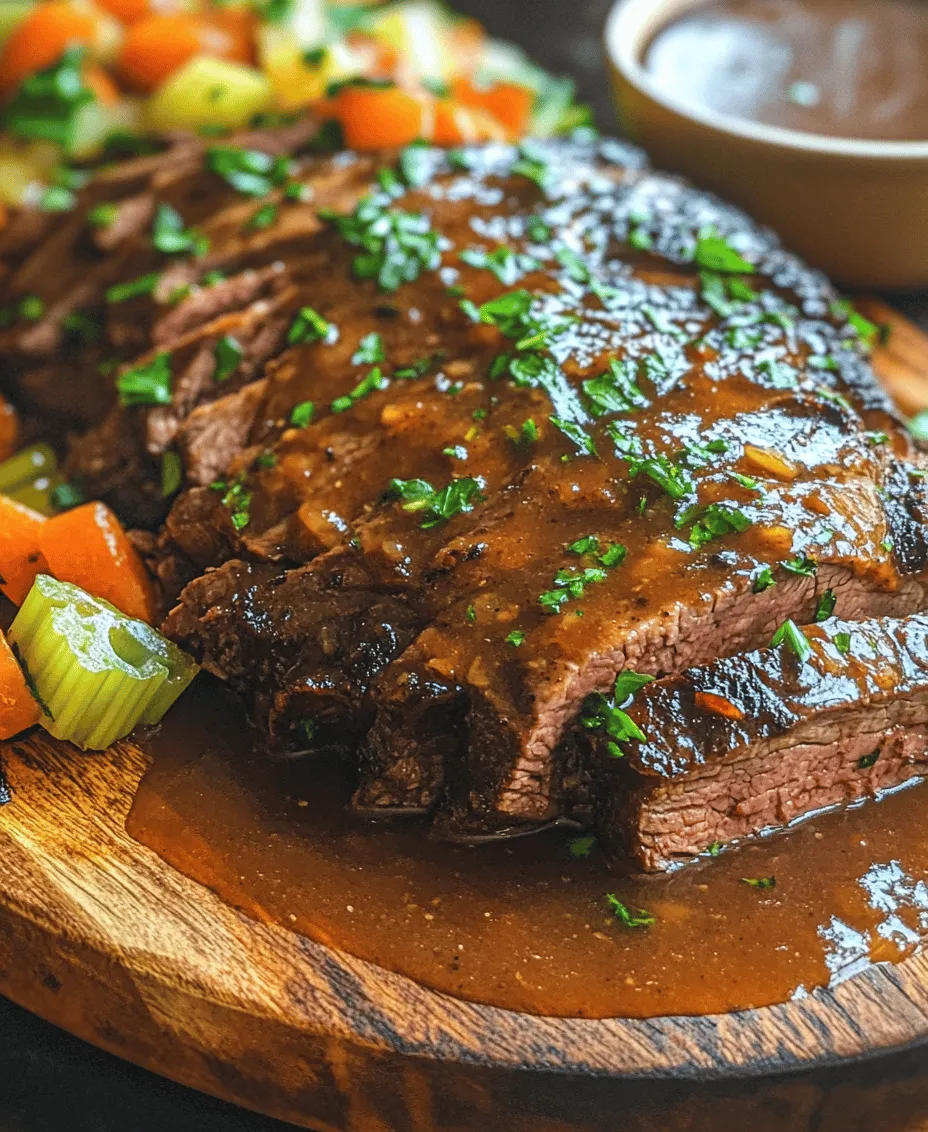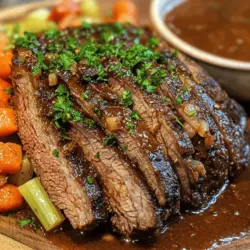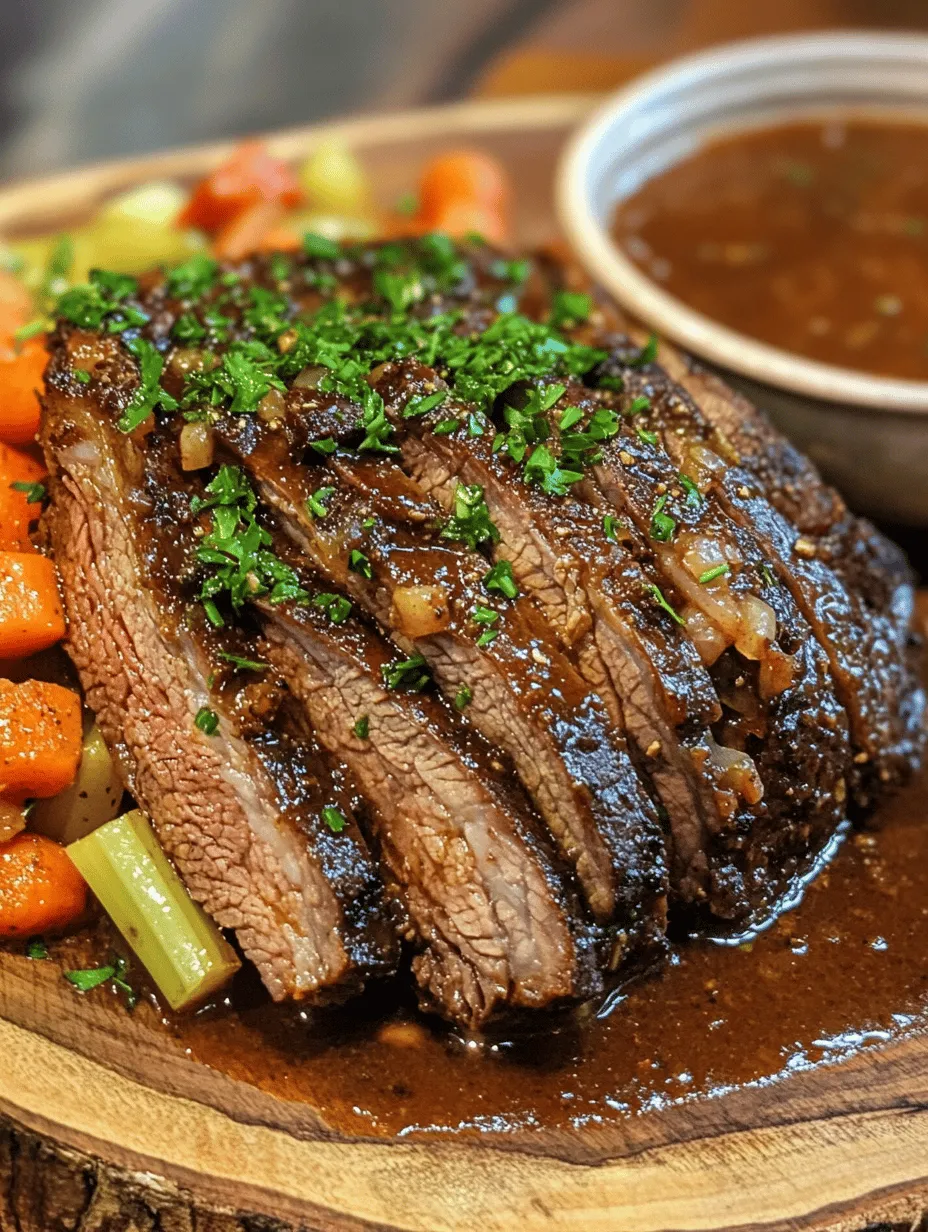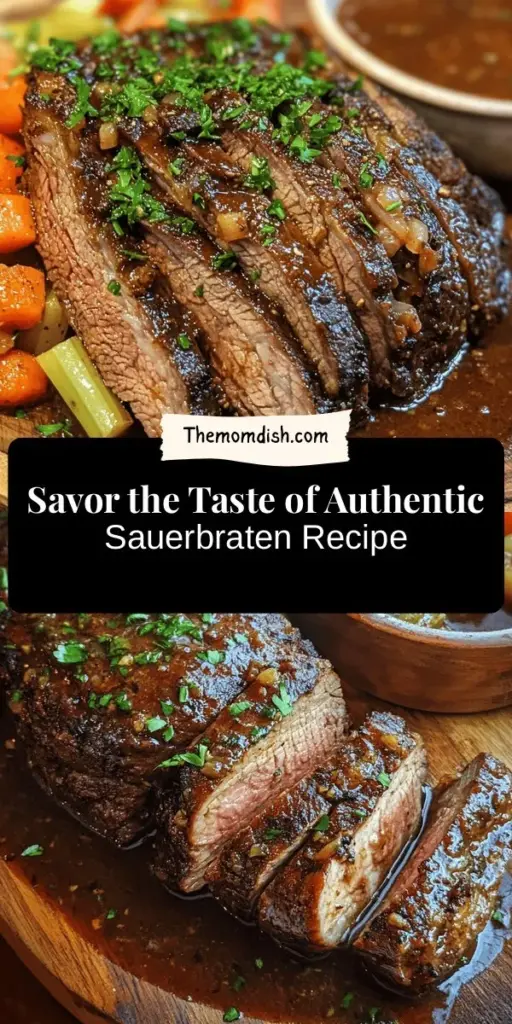Introduction
Sauerbraten, a classic dish hailing from Germany, is often revered as the country’s national pot roast. Its name translates to “sour roast,” a nod to the key process of marination that imbues the meat with a complex depth of flavor and tenderness. Traditionally made with beef, Sauerbraten is a dish that showcases the heart of German cooking—rich, comforting, and meant to be shared among family and friends. The magic of Sauerbraten lies not only in its savory profile but also in the patience required to achieve the perfect roast, making it a splendid centerpiece for family gatherings and special occasions.
What sets Sauerbraten apart from other pot roasts is its unique preparation method, primarily centered around a flavorful marinade that typically incorporates red wine vinegar, red wine, and a variety of aromatic spices. This meticulous marination process is crucial, as it not only enhances the flavor but also tenderizes the meat, resulting in a succulent dish that is as pleasing to the palate as it is to the eye. As we venture into the preparation of Sauerbraten, you will discover how this dish transcends mere sustenance and becomes a cherished culinary tradition that evokes warmth and togetherness.
Understanding Sauerbraten
Historical Background of Sauerbraten
The origins of Sauerbraten can be traced back to the Middle Ages, where it was a common method of preserving meat. In times when refrigeration was non-existent, marinating meat in vinegar and spices was a practical solution that allowed households to extend the shelf life of their cuts. Over the centuries, this method evolved into what we now recognize as Sauerbraten, each region of Germany adding its own unique twist to the recipe.
In fact, the preparation of Sauerbraten varies significantly across different areas. For instance, the Rhineland version often includes a sweeter element, such as raisins or gingerbread, to balance the tanginess of the marinade, whereas the Franconian variant leans towards a spicier profile, incorporating ingredients like juniper berries. This regional diversity not only highlights the versatility of the dish but also reflects the rich tapestry of German gastronomy.
Cultural Significance and Occasions for Serving Sauerbraten
Sauerbraten is more than just a meal; it holds a special place in German culture. Traditionally served during significant gatherings, holidays, and celebrations, this pot roast often finds its way to the dining tables for occasions like Christmas, Easter, and family reunions. The process of preparing Sauerbraten is often seen as a labor of love, where generations come together to pass down the recipe and share stories, making it a dish steeped in family heritage.
Moreover, the dish’s comforting nature makes it a favorite during colder months, providing a warm and hearty meal that brings people together. Whether served with traditional accompaniments such as red cabbage, potato dumplings, or a rich gravy, Sauerbraten resonates with the essence of home-cooked meals that evoke nostalgia and joy.
Ingredients Breakdown
To create an authentic Sauerbraten, it is essential to understand the importance of each ingredient. The right combination of flavors is crucial to achieving that signature taste that has made this dish a timeless classic.
Key Ingredients
1. Quality Beef Roast: The choice of beef is critical to the success of your Sauerbraten. Generally, beef chuck is preferred due to its marbling and flavor, which contribute to a tender roast after the long cooking process. However, some may opt for beef round, which is leaner but can be used effectively if marinated well.
2. Red Wine Vinegar and Red Wine: These two components form the cornerstone of the marinade. The acidity of red wine vinegar helps to tenderize the meat while imparting a distinct tanginess that balances the rich flavors. A full-bodied red wine complements the dish and enhances its depth.
3. Aromatics: Onions, carrots, celery, and garlic are essential for building a robust flavor profile. These vegetables not only add sweetness and aroma but also contribute to the overall texture of the dish.
4. Spices: A blend of black peppercorns, cloves, and bay leaves adds complexity to the marinade. The spices should be used in moderation, allowing the natural flavors of the beef and aromatic vegetables to shine through.
5. Additional Flavor Enhancers: Sugar, salt, vegetable oil, and beef broth play supporting roles in the recipe. Sugar balances out the acidity, while salt enhances the overall flavor. Vegetable oil is used for browning the meat, and beef broth is often incorporated during the cooking process to enrich the gravy.
6. Optional Ingredients: For those looking to achieve a thicker gravy, cornstarch can be added as a thickening agent. Additionally, some variations might include a splash of soy sauce or Worcestershire sauce for added umami.
Understanding the role of each ingredient allows you to appreciate the intricacies of Sauerbraten and how they contribute to the final dish. Selecting quality products and fresh produce is paramount to bringing out the best flavors.
Preparation Steps for Sauerbraten
Marinating the Beef
The first and most critical step in preparing Sauerbraten is marinating the beef. This process is what transforms a simple cut of meat into a culinary masterpiece. Here’s how to do it properly:
1. Prepare the Marinade: In a large bowl or pot, combine red wine vinegar, red wine, chopped onions, carrots, celery, minced garlic, black peppercorns, cloves, bay leaves, sugar, and salt. This mixture should be well-combined to ensure that all flavors intermingle.
2. Submerge the Beef: Place the beef roast into the marinade, ensuring it is fully submerged. If necessary, use a heavy plate to weigh it down. The key here is to allow the marinade to penetrate the meat thoroughly.
3. Marination Time: Cover the bowl or pot and refrigerate the beef for a minimum of 3 days, up to a full week. The longer you marinate, the more intense the flavor will become. Be sure to turn the meat every day to ensure even marination. This is crucial, as it allows all sides of the roast to absorb the flavors and tenderize uniformly.
Preparing the Beef for Cooking
Once the marination period is complete, it’s time to prepare the beef for cooking:
1. Remove and Pat Dry: Take the beef roast out of the marinade and gently pat it dry with paper towels. This step is essential as it helps achieve a good sear when browning the meat. Excess moisture can lead to steaming rather than browning.
2. Searing the Meat: In a large pot or Dutch oven, heat vegetable oil over medium-high heat. Once the oil is shimmering, carefully place the beef roast into the pot. Sear the meat on all sides until it develops a rich, brown crust. This caramelization adds depth to the final dish and creates a flavorful base for the gravy.
3. Deglazing: After searing, remove the beef and set it aside. Pour a small amount of the reserved marinade into the pot to deglaze, scraping up any browned bits from the bottom. This step is key in building a richly flavored gravy.
The preparation of Sauerbraten is a labor-intensive yet rewarding process that requires attention to detail and patience. The culmination of these steps is a dish that not only tantalizes the taste buds but also embodies the spirit of German cuisine.
In the next section, we will delve into the cooking process and the finishing touches that will elevate your Sauerbraten to new heights.

Techniques for Searing to Enhance Flavor
Searing is a crucial step in creating a rich and flavorful Sauerbraten. This technique involves cooking the meat over high heat to develop a caramelized crust, which adds depth to the overall flavor profile of the dish. To achieve the perfect sear, start by patting the beef roast dry with paper towels. Moisture on the surface will create steam instead of allowing for a good sear. Season the meat generously with salt and pepper before placing it in a hot, heavy-bottomed skillet or Dutch oven with a little oil.
Allow the meat to sear undisturbed for a few minutes until a golden-brown crust forms on one side, then turn it to sear all sides evenly. This process not only locks in juices but also creates what is known as “fond” – those beautiful brown bits left behind in the pan, which are essential for building a rich sauce.
Sautéing Aromatics and Building the Base for the Sauce
Once your meat is beautifully seared, it’s time to sauté the aromatics. Remove the roast from the pan and set it aside. In the same pan, add onions, carrots, and celery, cooking them on medium heat until they are softened and slightly caramelized. This step is crucial as it builds the flavor foundation for your Sauerbraten’s sauce.
Next, add minced garlic and cook for an additional minute until fragrant. The goal is to extract the sweetness from the vegetables and build complexity in the sauce. After the aromatics are sufficiently sautéed, deglaze the pan by adding a splash of red wine or beef broth. This process involves using a wooden spoon to scrape up the fond from the bottom of the pan, incorporating those flavorful bits into your sauce.
Slow Cooking for Perfection
Slow cooking is the heart of the Sauerbraten recipe, and it’s where the magic truly happens. After sautéing the aromatics, return the seared meat to the pot and pour in your marinated mixture, including any leftover marinade from the soaking process. Bring the liquid to a gentle simmer before covering the pot and transferring it to a preheated oven set to low heat, around 300°F (150°C).
The importance of this slow cooking process cannot be overstated. Cooking the meat at low temperatures for several hours allows the tough connective tissues to break down, resulting in tender, melt-in-your-mouth beef. Generally, you should aim for a cooking time of 3 to 4 hours, depending on the size of your roast.
To check for doneness, use a fork to pierce the meat gently; it should offer little resistance and feel fork-tender when it’s ready to be removed from the pot. This slow cooking technique not only enhances tenderness but also allows the flavors to meld beautifully, creating a dish that is rich and satisfying.
Finishing Touches
Once your Sauerbraten has cooked to perfection, it’s time to finish the dish. If you desire a thicker sauce, remove the meat from the pot and place it on a cutting board to rest. Meanwhile, bring the remaining liquid in the pot to a boil over medium-high heat. Allow it to reduce slightly, or you can mix a cornstarch slurry (1 tablespoon cornstarch mixed with 2 tablespoons cold water) and stir it into the sauce to thicken it quickly.
Resting the meat is an essential step; letting it sit for about 10-15 minutes ensures the juices redistribute, making for a moist and flavorful roast. After resting, slice the meat against the grain into thick pieces for serving.
When plating, arrange the slices on a large serving dish and generously spoon the rich sauce over the top. For an attractive finish, garnish with freshly chopped parsley, which adds a pop of color and a hint of fresh flavor to the dish.
Pairing Suggestions
Sauerbraten is traditionally served with a variety of side dishes that complement its robust flavors. Classic accompaniments include red cabbage, buttered noodles, or potato dumplings. The acidity of the red cabbage balances the richness of the meat, while the noodles or dumplings help soak up the delectable sauce.
For beverage pairings, consider serving a glass of dry red wine, such as a Pinot Noir or a hearty Chianti. These wines pair wonderfully with the deep flavors of the Sauerbraten and enhance the overall dining experience. Additionally, a light German beer or a refreshing apple cider can provide a delightful contrast to the dish’s richness.
If you’re looking to explore cultural dishes that can be served alongside Sauerbraten, consider a side of spätzle, a traditional German egg noodle, or a fresh green salad dressed with a tangy vinaigrette to brighten the palate. Each of these accompaniments will create a well-rounded meal that celebrates the flavors of German cuisine.
Nutritional Information
Sauerbraten is not only a delicious dish but also offers several nutritional benefits. The main ingredient, beef, is a great source of protein, iron, and essential vitamins like B12, which is vital for maintaining energy levels and supporting overall health. The accompanying vegetables, such as onions and carrots, add fiber, vitamins, and antioxidants, contributing to a balanced meal.
When considering portion sizes, a standard serving of Sauerbraten is approximately 4-6 ounces of meat, paired with a generous helping of sauce and sides. This allows for a hearty meal without overindulging, making it suitable for family gatherings or special occasions.
Conclusion
Sauerbraten holds a special place in German cuisine, cherished for its rich flavors and tender texture. This traditional pot roast not only embodies the essence of comfort food but also brings families and friends together around the dinner table. Preparing Sauerbraten at home is an opportunity to explore the art of slow cooking while creating lasting memories with loved ones.
As you embark on making this recipe, take pride in the process and the flavors that develop with each step. The joy of sharing traditional recipes is about more than just the food; it’s about the stories, the laughter, and the connections created through a shared meal. So gather your ingredients, follow the steps, and enjoy the experience of crafting your own Sauerbraten bliss in the comfort of your kitchen.



